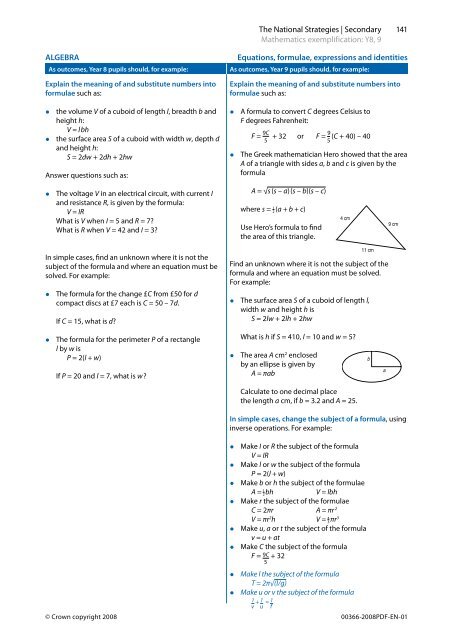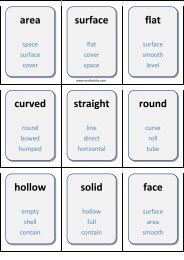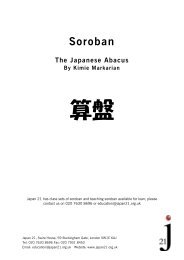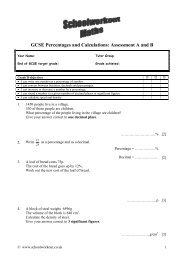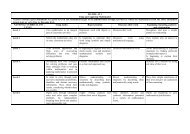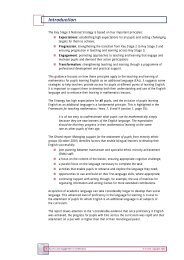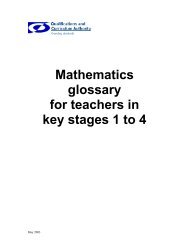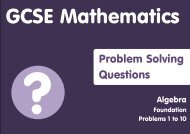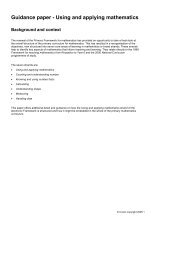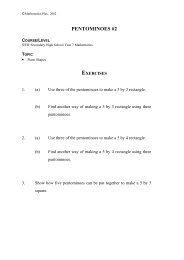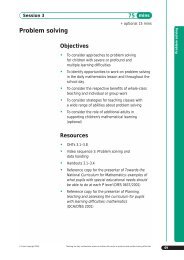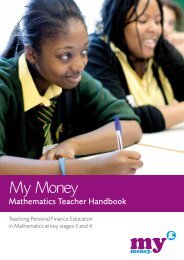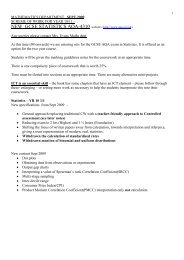ALGEBRA Equations, formulae, expressions and ... - Suffolk Maths
ALGEBRA Equations, formulae, expressions and ... - Suffolk Maths
ALGEBRA Equations, formulae, expressions and ... - Suffolk Maths
You also want an ePaper? Increase the reach of your titles
YUMPU automatically turns print PDFs into web optimized ePapers that Google loves.
The National Strategies | Secondary<br />
Mathematics exemplification: Y8, 9<br />
141<br />
<strong>ALGEBRA</strong><br />
As outcomes, Year 8 pupils should, for example:<br />
Explain the meaning of <strong>and</strong> substitute numbers into<br />
<strong>formulae</strong> such as:<br />
• the volume V of a cuboid of length l, breadth b <strong>and</strong><br />
height h:<br />
V = l bh<br />
•<br />
the surface area S of a cuboid with width w, depth d<br />
<strong>and</strong> height h:<br />
S = 2dw + 2dh + 2hw<br />
Answer questions such as:<br />
•<br />
The voltage V in an electrical circuit, with current I<br />
<strong>and</strong> resistance R, is given by the formula:<br />
V = IR<br />
What is V when I = 5 <strong>and</strong> R = 7?<br />
What is R when V = 42 <strong>and</strong> I = 3?<br />
In simple cases, find an unknown where it is not the<br />
subject of the formula <strong>and</strong> where an equation must be<br />
solved. For example:<br />
• The formula for the change £C from £50 for d<br />
compact discs at £7 each is C = 50 – 7d.<br />
If C = 15, what is d?<br />
•<br />
The formula for the perimeter P of a rectangle<br />
l by w is<br />
P = 2(l + w)<br />
If P = 20 <strong>and</strong> l = 7, what is w?<br />
<strong>Equations</strong>, <strong>formulae</strong>, <strong>expressions</strong> <strong>and</strong> identities<br />
As outcomes, Year 9 pupils should, for example:<br />
Explain the meaning of <strong>and</strong> substitute numbers into<br />
<strong>formulae</strong> such as:<br />
• A formula to convert C degrees Celsius to<br />
F degrees Fahrenheit:<br />
•<br />
F = 9C + 32 or F = 9 (C + 40) – 40<br />
5 5<br />
The Greek mathematician Hero showed that the area<br />
A of a triangle with sides a, b <strong>and</strong> c is given by the<br />
formula<br />
A = √s (s – a)(s – b)(s – c)<br />
1<br />
where s = (a + b + c)<br />
2<br />
Use Hero’s formula to find<br />
the area of this triangle.<br />
4 cm<br />
Find an unknown where it is not the subject of the<br />
formula <strong>and</strong> where an equation must be solved.<br />
For example:<br />
• The surface area S of a cuboid of length l,<br />
width w <strong>and</strong> height h is<br />
S = 2lw + 2lh + 2hw<br />
What is h if S = 410, l = 10 <strong>and</strong> w = 5?<br />
• The area A cm2 enclosed<br />
by an ellipse is given by<br />
A = πab<br />
11 cm<br />
b<br />
a<br />
9 cm<br />
Calculate to one decimal place<br />
the length a cm, if b = 3.2 <strong>and</strong> A = 25.<br />
In simple cases, change the subject of a formula, using<br />
inverse operations. For example:<br />
• Make I or R the subject of the formula<br />
V = IR<br />
• Make l or w the subject of the formula<br />
P = 2(l + w)<br />
• Make b or h the subject of the <strong>formulae</strong><br />
1<br />
A = 2 bh<br />
V = lbh<br />
•<br />
Make r the subject of the <strong>formulae</strong><br />
C = 2πr A = πr 2<br />
V = πr 2 h<br />
4<br />
V = πr 3<br />
3<br />
• Make u, a or t the subject of the formula<br />
v = u + at<br />
•<br />
Make C the subject of the formula<br />
F = 9C + 32<br />
5<br />
• Make l the subject of the formula<br />
T = 2π√(l/g)<br />
•<br />
Make u or v the subject of the formula<br />
1 + 1 = 1<br />
v u f<br />
© Crown copyright 2008 00366-2008PDF-EN-01


